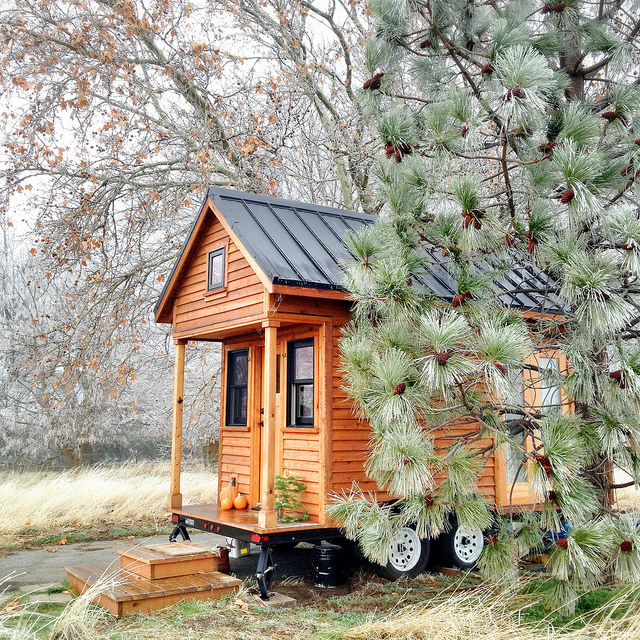
By Anthony Martinez
A tiny revolution is taking shape within the U.S. housing market—quite literally. All across the land of “bigger is better,” tenacious homeowners are turning their will and all their DIY savvy toward constructing radically smaller houses. Their intentions include leading a clutter-free life, avoiding the burden of a conventional mortgage and, most importantly, owning a house that authentically embodies their personal values.
And even a cursory glance into the Tiny House Movement will reveal no shortage of authenticity. Many are cobbled together out of reclaimed or recycled materials. Most are constructed by the homeowners themselves—a practice so endemic to the movement that many tiny house owners have blogs chronicling the construction of their houses. Ranging from prefabricated shelters for hurricane victims to hyper-modern Ecocapsules that run on solar and wind power, the Tiny House Movement boasts a truly motley constituency. Motley—and enthusiastic.
Try finding one tiny house inhabitant who exhibits the moderate, amiable pride of an average homeowner. Frankly, they don’t exist. Tiny homeowners love their houses. They proclaim their fiscal and spiritual benefits with an enthusiasm that borders on fanaticism. And there’s a lot of hard data to back this enthusiasm up. A tiny home costs significantly less money than the average American home—especially if constructed by the owner. Nearly 68 percent of tiny homeowners don’t have a mortgage (compared to 29.3 percent of all U.S. homeowners). Predictably, a tiny house’s impact on the environment is dramatically lower than the standard U.S. residence—both in terms of waste produced and resources consumed.
So how soon until we see the rise of tiny cities? Or microburbs filled with residents spiritually connected to their self-constructed homes and communities?
Not any time soon.
For all its charm and verve, there are many reasons why the Tiny House Movement might play out as more of a cold than a fever.
Zoning
One curious feature of tiny houses: Many are portable. Mounted on trailer beds, a number of tiny houses are capable of being transported from place to place—often to locations in the wilderness. This dovetails nicely with the movement’s ethos of independence. However, this quirk is not just another form of structural autonomy; it is also a way to circumvent zoning regulations.
By square footage, most tiny houses do not meet the minimum habitable structure definition. Your county’s zoning officials will most likely fine or condemn a tiny house unless you file for a variance—an arduous, time-consuming process that essentially permits you to construct an exception to the local zoning codes. Hence: the trailers. However, even this doesn’t always work.
Loans
But what if your home is your castle, and that castle needs to be located firmly on land? Then you’ll need to purchase land, and that will require a mortgage. So how interested are banks in funding tiny houses?
About as interested as you are in purchasing tinier food. Currently, tiny houses have little market value. If your loan forecloses, the house provides virtually no collateral to the bank. In fact, banks and courts rarely view tiny houses as an asset, making them less likely to place a lien on tiny residences or repossess them. Good news for anybody who has fallen on rough times while financing a tiny home. Bad news for anybody trying to secure a loan for a tiny house in the first place.
Breaking With Tradition
Tiny houses are fundamentally an atypical housing choice. Committing to a decision that deviates from a familiar life narrative is psychologically difficult—at times, utterly terrifying. Prompted to sign onto a tiny house right now—take out a loan, file for variances, etc.—many people would balk.
But perhaps the best response to adversity comes from this little excerpt from Ryan Mitchell’s book, “Tiny House Living”:
“If you had more time in this world and could spend it however you choose, what would you do? Give some serious thought to that question.”
Located at the bottom of the page are four blank lines for writing your answer. The challenge of the Tiny House Movement is to ask yourself what you truly value, to recalibrate your concept of success. What does that look like?
As suggested, take your time.
ABOUT THE AUTHOR
Anthony Martinez is pursuing his Master of Fine Arts in creative writing at Emerson College. Follow him @afidelmartinez.


Photograph of a tiny house courtesy of Tammy Strobel via Flickr Creative Commons


